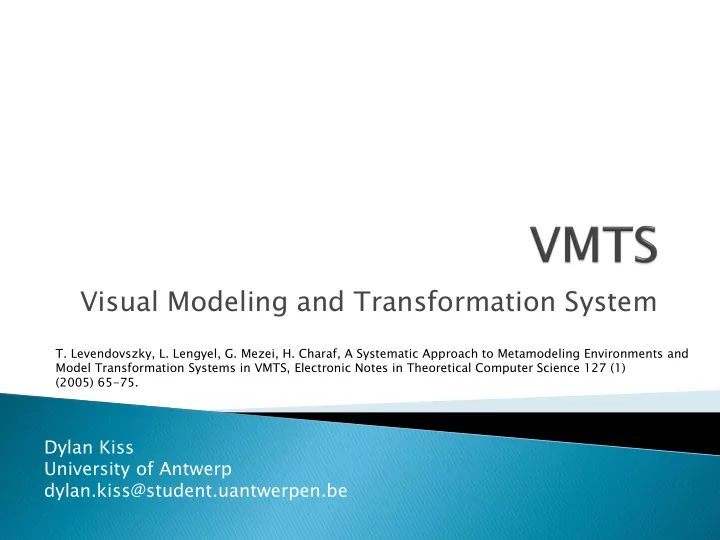

Visual Modeling and Transformation System T. Levendovszky, L. Lengyel, G. Mezei, H. Charaf, A Systematic Approach to Metamodeling Environments and Model Transformation Systems in VMTS, Electronic Notes in Theoretical Computer Science 127 (1) (2005) 65-75. Dylan Kiss University of Antwerp dylan.kiss@student.uantwerpen.be
N-layer metamodeling environment Simplified UML class diagrams UML class diagram instantiation: ◦ UML object diagram ◦ UML class diagram ◦ Metamodel of UML class diagram Two more layers: ◦ Read-only meta-metamodel ◦ Internal structure: labeled directed graph
AGSI ◦ Attributed Graph Architecture Supporting Inheritance Every model can be a metamodel for others Meta-meta- Meta N … Meta-meta Meta Model meta
3 basic graph constructs: ◦ Nodes ◦ Directed edges ◦ Labels Metamodeling needs extra things: ◦ Type-instance mapping ◦ Containment ◦ Inheritance ◦ Association classes
Type-instance mapping v3 V1 v4 V2 v5 v6
Containment ◦ Parent-child bidirectional mapping Inheritance ◦ Directed mapping from descendants to ancestors Association classes ◦ Pseudo-nodes
Model attributes (labels in directed graph) ◦ Stored in XMI-like format ◦ Meta-attributes that can be instantiated are stored in XSD file Schema for XML file on instance level
Traversing Model Processors ◦ Create node ◦ Connect nodes ◦ Delete node ◦ Delete edge ◦ Set label Regular objects in OO programming language
Visual Model Processors ◦ Graph rewriting ◦ Rules with LHS and RHS Rules specified in terms of metamodel Attribute transformation with XSLT scripts
Role-Playing Game modeling in VMTS ◦ Metamodel (abstract syntax) ◦ Concrete visual syntax ◦ Transformation rules Operational semantics Denotational semantics ◦ Compare with AToMPM and state advantages and disadvantages
Recommend
More recommend